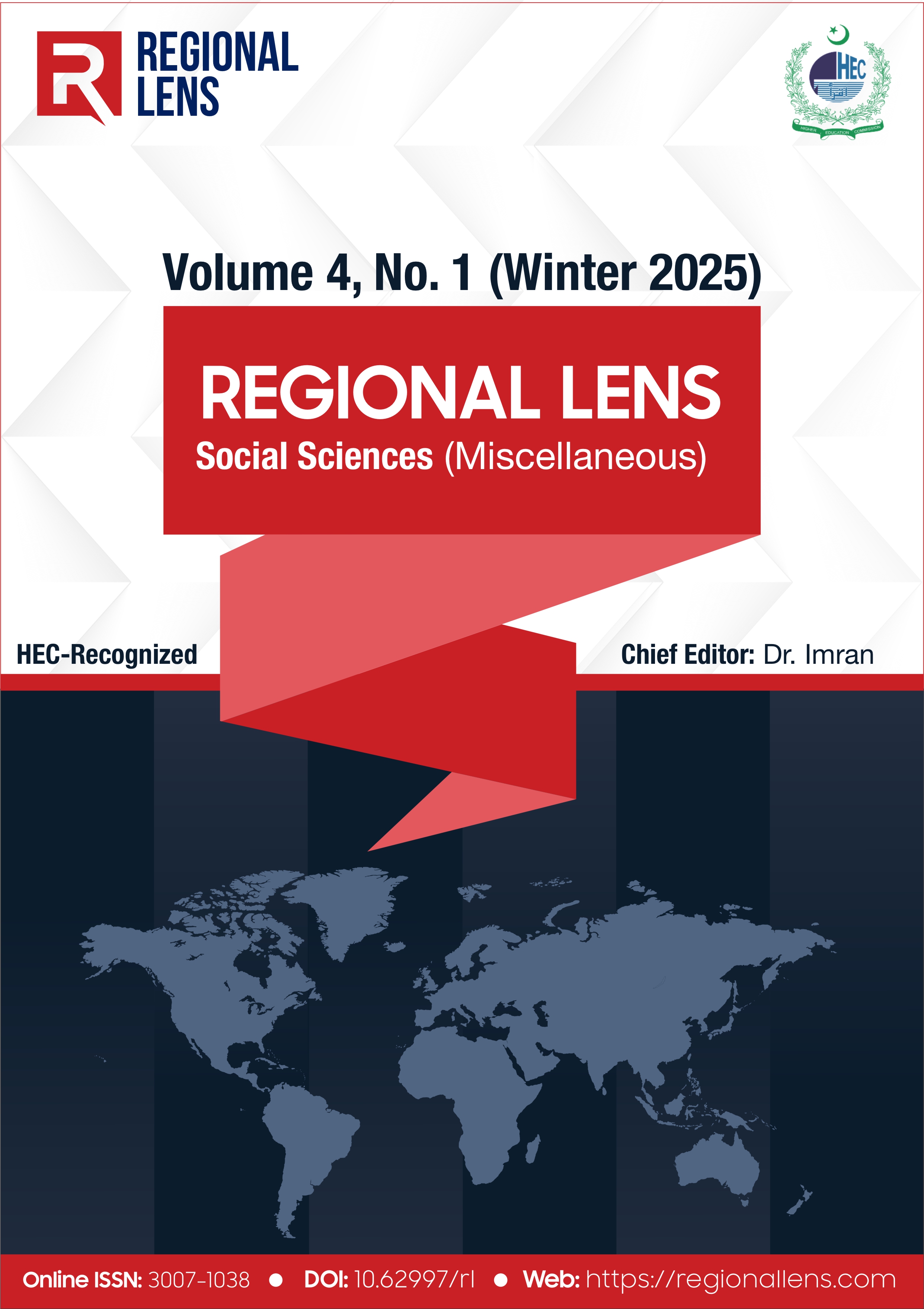Visualizing Masculinity: A Photovoice Analysis of Pakistani Men’s Self-Presentation on Facebook
DOI:
https://doi.org/10.55737/rl.2025.41075bKeywords:
Masculinity, Pakistani Men, Facebook, Photovoice Lense, CommunicationAbstract
Over the past decade, social media, particularly Facebook, has significantly transformed communication in Pakistan, influencing how people interact. This change is particularly significant given Pakistan's socio-cultural and religious contexts. Facebook serves as both a platform for challenging established gender roles and a location in which such standards may be perpetuated. As a result, it has evolved as a space for the continual creation of gender identities. Using Multimodal Discourse Analysis, this study looks at how Pakistani males portray and shape their masculine identities on Facebook. The findings indicate that, while conventional norms are mostly retained, there are some subtle deviations from established ideals of masculinity.
References
AlphaPro. (2018, June 1). Pakistan social media stats 2018.
Aslam, M. (2014). Islamism and masculinity: Case study Pakistan. Historical Social Research / Historische Sozialforschung 39(3),135-149. https://doi.org/10.12759/HSR.39.2014.3.135-149
Aslam, M. H., Mahmood, S. A., & Saeed, M. M. (2022). Hegemonic masculinity in Pakistan: A critical study of selected Pakistani TV serials. Journal of Social Sciences Advancement, 3(4), 224–229. https://doi.org/10.52223/jssa22-030405-51
Balaji, M. (2014). Exporting Indian masculinity. Technoculture: An Online Journal of Technology in Society, 4.
Bano, S. R., Bilal, M., & Azam, S. (2021). Digital Activism And Political Engagement Of Pakistani Youth On Social Media: A Netnographic Exploration. Pakistan Journal of Society, Education & Language, 8(1). https://pjsel.jehanf.com/index.php/journal/article/view/628
Benwell, B., & Stokoe, E. (2006). Discourse and identity. Edinburgh University Press.
Boyd, D. M., & Ellison, N. B. (2007). Social network sites: Definition, history, and scholarship. Journal of Computer-Mediated Communication: JCMC, 13(1), 210–230. https://doi.org/10.1111/j.1083-6101.2007.00393.x
Connell, R. W., & Messerschmidt, J. W. (2005). Hegemonic masculinity: Rethinking the concept. Gender & Society: Official Publication of Sociologists for Women in Society, 19(6), 829–859. https://doi.org/10.1177/0891243205278639
Coston, B. M., & Kimmel, M. (2012). Seeing privilege where it isn’t: Marginalized masculinities and the intersectionality of privilege. The Journal of Social Issues, 68(1), 97–111. https://doi.org/10.1111/j.1540-4560.2011.01738.x
Danet, B. (1998). Text as mask: Gender, play, and performance on the Internet. In S. G. Jones (Ed.), Cybersociety 2.0: Revisiting computer-mediated communication and community (pp. 129–158). Sage Publications, Inc. https://doi.org/10.4135/9781452243689.n5
De Sondy, A. (2009). Constructions of masculinities in Islamic traditions, societies and cultures, with a specific focus on India and Pakistan between the 18th-21st Century (Doctoral dissertation, University of Glasgow).
Eisen, D. B., & Yamashita, L. (2019). Borrowing from femininity: The caring man, hybrid masculinities, and maintaining male dominance. Men and Masculinities, 22(5), 801-820. https://doi.org/10.1177/1097184X17728552
Genter, E. N. (2014). The association of masculinity themes in social network images and sexual risk behavior (Master's thesis, Yale University).
Ging, D., & Siapera, E. (2018). Special issue on online misogyny. Feminist Media Studies, 18(4), 515–524. https://doi.org/10.1080/14680777.2018.1447345
Groenewald, T. (2004) A Phenomenological Research Design Illustrated. International Journal of Qualitative Methods, 3, 1-26. https://doi.org/10.1177/160940690400300104
Jafar, A. (2005). Women, Islam, and the state in Pakistan. Gender issues, 22(1), 35-55. https://doi.org/10.1007/s12147-005-0009-z
Jones, R. (2015). Discourse, cybernetics, and the textualization of the self. In R. H. Jones, A. Chik, & C. Hafner (Eds.), Discourse and digital practices: Doing discourse analysis in the digital age (pp. 28–47). Routledge.
Karamat, A., & Farooq, D. A. (2020). Emerging role of social media in political activism: Perceptions and practices. South Asian Studies, 31(1).
Khan, A. (2018). Pious masculinity, ethical reflexivity, and moral order in an Islamic piety movement in Pakistan. Anthropological Quarterly, 91(1), 53–77. https://doi.org/10.1353/anq.2018.0002
KhosraviNik, M., & Esposito, E. (2018). Online hate, digital discourse and critique: Exploring digitally-mediated discursive practices of gender-based hostility. Lodz Papers in Pragmatics, 14(1), 45–68. https://doi.org/10.1515/lpp-2018-0003
Kiesling, S. (2007). Men, masculinities, and language: Men, masculinities, and language. Language and Linguistics Compass, 1(6), 653–673. https://doi.org/10.1111/j.1749-818x.2007.00035.x
Lamont, E. (2015). The limited construction of an egalitarian masculinity: College-educated men’s dating and relationship narratives. Men and Masculinities, 18(3), 271–292. https://doi.org/10.1177/1097184X14557495
Light, B., & Cassidy, E. (2014). Strategies for the suspension and prevention of connection: Rendering disconnection as socioeconomic lubricant with Facebook. New Media & Society, 16(7), 1169-1184. https://doi.org/10.1177/1461444814544002
Macken-Horarik, M. (2004). Interacting with the multimodal text: Reflections on image and verbiage in Art Express. Visual Communication, 3(1), 5–26. https://doi.org/10.1177/1470357204039596
Marwick, A. E. (2013). Status update: Celebrity, publicity, and branding in the social media age. Yale University Press
Mendes, K., Keller, J., & Ringrose, J. (2018). Digitized narratives of sexual violence: Making sexual violence felt and known through digital disclosures. New Media & Society, 21(6), 1290-1310. https://doi.org/10.1177/1461444818820069
Mendes, K., Ringrose, J., & Keller, J. (2019). Digital Feminist Activism: Girls and Women Fight Back against Rape Culture. Oxford University Press
Messerschmidt, J. W., & Messner, M. A. (2018). Hegemonic, nonhegemonic, and "new" masculinities. In J. W. Messerschmidt, P. Y. Martin, M. A. Messner, & R. Connell (Eds.), Gender reckonings: New social theory and research (pp. 35–56). New York University Press. https://doi.org/10.2307/j.ctt1pwtb3r.7
Mullany, L. (2004). ‘Become the man that women desire’: gender identities and dominant discourses in email advertising language. Language and Literature (Harlow, England), 13(4), 291–305. https://doi.org/10.1177/0963947004046277
Patterson, J. (2013). Constructions of violence and masculinity in the digital age. In Internet research, theory, and practice: perspectives from Ireland (pp. 113–133). Research-publishing.net.
Pillay, N. (2008). The protrayal of women in television advertisements on SABC3: a reflection on stereotypical representation. University of the Witwatersrand, Johannesburg (South Africa).
Ress, G., & Van Leeuwen, T. (2006). Reading Images: The Grammar of Visual Design. London/ New York: Routledge.
Schmitz, R. M., & Kazyak, E. (2016). Masculinities in Cyberspace: An Analysis of Portrayals of Manhood in Men’s Rights Activist Websites. Social Sciences, 5(2), 18. https://doi.org/10.3390/socsci5020018
Szulc, L. (2018). Transnational Homosexuals in Communist Poland: Cross-Border Flows in Gay and Lesbian Magazines. (Global Queer Politics). Palgrave Macmillan. https://doi.org/10.1007/978-3-319-58901-5_8
Ullah, H., Khan, A. N., Khan, H. N., & Ibrahim, A. (2016). Gender representation in Pakistani print media: A critical analysis. Pakistan Journal of Gender Studies, 12(1), 53–70. https://doi.org/10.46568/pjgs.v12i1.199
Yazdani, M., & Manovich, L. (2015). Predicting social trends from non-photographic images on Twitter. 2015 IEEE International Conference on Big Data (Big Data). http://dx.doi.org/10.1109/BigData.2015.7363935




